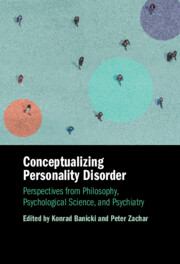 Conceptualizing Personality Disorder
Conceptualizing Personality Disorder Book contents
- Conceptualizing Personality Disorder
- Conceptualizing Personality Disorder
- Copyright page
- Contents
- Figures
- Tables
- Contributors
- Introduction
- Part I Historical Perspectives
- Part II Contemporary Approaches to Traditional Conceptual Perspectives
- 4 The Psychodynamic Core of Personality Disorder
- 5 Multiple Roads to Pathology
- 6 A Contemporary Integrative Interpersonal Theory Formulation of Self and Social Pathology
- 7 The Inflexible Self and Lived Time
- 8 Psychopharmacology and Personality Disorder
- 9 When Do Personality Traits Become Pathological?
- Part III Novel Conceptual Approaches to Personality Disorder
- Part IV Exploring Negative Consequences of Diagnosing Personality Disorder
- Part V Perspectives on Borderline and Narcissistic Personality
- Index
- References
7 - The Inflexible Self and Lived Time
A Phenomenological Approach to Personality Disorders
from Part II - Contemporary Approaches to Traditional Conceptual Perspectives
Published online by Cambridge University Press: 25 June 2025
- Conceptualizing Personality Disorder
- Conceptualizing Personality Disorder
- Copyright page
- Contents
- Figures
- Tables
- Contributors
- Introduction
- Part I Historical Perspectives
- Part II Contemporary Approaches to Traditional Conceptual Perspectives
- 4 The Psychodynamic Core of Personality Disorder
- 5 Multiple Roads to Pathology
- 6 A Contemporary Integrative Interpersonal Theory Formulation of Self and Social Pathology
- 7 The Inflexible Self and Lived Time
- 8 Psychopharmacology and Personality Disorder
- 9 When Do Personality Traits Become Pathological?
- Part III Novel Conceptual Approaches to Personality Disorder
- Part IV Exploring Negative Consequences of Diagnosing Personality Disorder
- Part V Perspectives on Borderline and Narcissistic Personality
- Index
- References
Summary
This chapter sheds light on phenomenological aspects of personality disorders. Although research on personality disorders has increased in the last decades, it remains relatively underexamined compared to other mental health conditions. This discrepancy is even more evident in phenomenological psychopathology. To fill this lacuna, this chapter offers an analysis of the implicit, temporal foundation of self-experience in personality disorders. It is argued that personality disorders can be understood in terms of a temporal inflexibility of the self. Important aspects of lived inflexibility are described across five topoi: repetitiveness of interpersonal patterns, affective rigidity, reification of self-experience, lack of future openness, and the feeling of being stuck.
Keywords
Information
- Type
- Chapter
- Information
- Conceptualizing Personality DisorderPerspectives from Philosophy, Psychological Science, and Psychiatry, pp. 130 - 146Publisher: Cambridge University PressPrint publication year: 2025